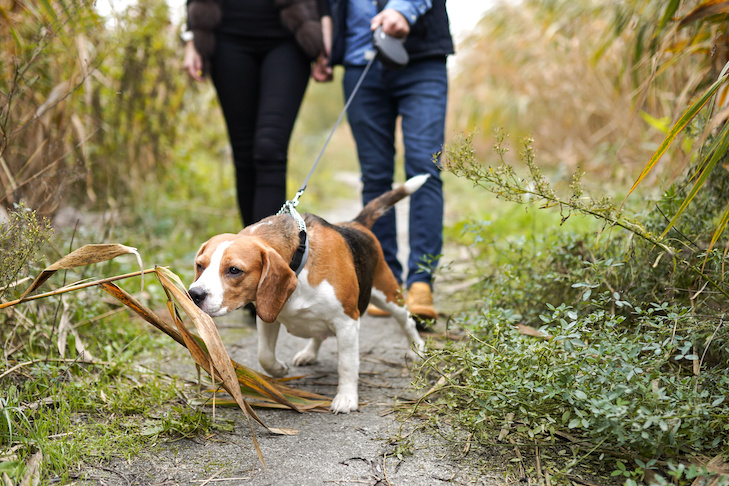Training your dog requires patience, consistency, and the right tools. One of the most versatile and popular pet accessories for both new and experienced dog owners is the retractable dog leash. While traditional fixed-length leashes have their place in training routines, retractable options offer a level of freedom and flexibility that can enhance certain aspects of dog training.
In this article, we’ll explore the key benefits of using retractable dog leashes, how they support effective training, and when they’re most appropriate. We’ll also address common concerns and best practices for safe use.
What Are Retractable Dog Leashes?
Retractable dog leashes consist of a long, thin cord or tape housed within a plastic handle. The leash extends and retracts automatically as the dog moves, controlled by a lock or brake button that lets the handler set the desired length.
Common features include:
- Leash lengths from 10 to 26 feet
- Ergonomic handles
- Reflective stitching or casing
- Tangle-free mechanisms
These leashes are particularly popular among pet owners who want to give their dogs more freedom during walks or outdoor training sessions without sacrificing control.
Benefits of Retractable Dog Leashes in Training
1. Teaches Distance Control
One of the biggest advantages of retractable dog leashes is their ability to teach a dog to stay within a certain range.
In early dog training, a pet may not yet understand recall commands or the importance of staying close. A retractable leash helps reinforce spatial boundaries by letting the dog explore while maintaining a consistent perimeter defined by the leash length.
This helps in:
- Recall training
- Distance obedience (e.g., sit or stay from a distance)
- Outdoor behavior correction
2. Builds Confidence in Timid Dogs
Some dogs, especially rescues or young puppies, are naturally timid or nervous in open spaces. Giving them freedom to move at their own pace while remaining securely attached helps build their confidence.
By using retractable dog leashes, trainers allow dogs to:
- Explore new environments gradually
- Approach other dogs or people at their own comfort level
- Gain independence while remaining under supervision
3. Great for Teaching Recall and Commands
One of the most challenging aspects of dog training is teaching your pet to come when called—especially in open areas with distractions.
A retractable leash provides a safe and effective way to practice recall. The dog can be allowed to wander, and when the recall command is given, you can observe and reinforce the behavior. If the dog doesn’t respond, the leash ensures they don’t get too far.
It’s also useful for commands such as:
- “Stay” while you increase your distance
- “Come” or “Heel” from a far point
- “Leave it” when distractions are present
Ideal Training Environments for Retractable Leashes
Retractable leashes are best used in open, safe areas where there’s plenty of space and limited traffic. Ideal settings include:
- Parks or open fields
- Dog training yards
- Beaches (with leash rules)
- Hiking trails
They are not recommended in:
- Crowded city sidewalks
- High-traffic areas
- Unpredictable environments (e.g., near wildlife or vehicles)
Safety Tips and Best Practices
Like any tool, retractable dog leashes must be used responsibly. Follow these tips for safe and effective use:
Know Your Dog’s Size and Strength
Choose a leash that’s appropriate for your dog’s weight and behavior. Some larger breeds may require heavy-duty retractable leashes rated for 100+ lbs.
Practice Braking and Locking
Learn how to quickly use the brake/lock mechanism to stop your dog from lunging or running too far.
Watch for Entanglement
Don’t allow the leash to wrap around your legs, arms, or other pets. The long cord can cause rope burns if mishandled.
Use in Open Spaces
Avoid tight or crowded areas where the extended leash could trip others or become a hazard.
Combine With Verbal Training
Use voice commands in tandem with leash control to reinforce behaviors. Don’t rely solely on the leash to “do the training.”
Choosing the Right Retractable Dog Leash
When shopping for a retractable leash, consider:
Leash Length
Shorter lengths (10–16 ft) are ideal for moderate control. Longer leashes (20–26 ft) are better for advanced training or open space use.
Material
- Tape leashes (flat ribbon) are more durable and visible.
- Cord leashes are lighter but may tangle or cause injuries if misused.
Grip and Comfort
Choose an ergonomic handle with a non-slip grip, especially if you walk your dog for extended periods.
Reflective Features
For low-light training, look for reflective tape or handles for better visibility.
Combining Retractable Leashes With Other Training Tools
Retractable leashes work best when used in combination with:
- Harnesses: Especially no-pull or front-clip designs that reduce strain.
- Clickers: For positive reinforcement when commands are obeyed.
- Treats or reward pouches: To reinforce recall or focus.
This integrated approach ensures more effective dog training sessions and better long-term results.
Common Misconceptions About Retractable Leashes
Myth 1: They encourage pulling.
Fact: Poor handling encourages pulling. When used correctly with commands, they can improve leash manners.
Myth 2: They’re unsafe.
Fact: They’re unsafe in the wrong environment or without proper supervision—just like any tool.
Myth 3: Only small dogs can use them.
Fact: Many retractable leashes are designed for dogs over 100 lbs.
Final Thoughts
Retractable dog leashes are a valuable training tool when used thoughtfully. They provide freedom, control, and a unique way to teach essential behaviors like recall, distance commands, and exploration boundaries.
While they shouldn’t replace standard leashes in every situation, they make an excellent addition to your pet accessories collection—especially if you’re working on outdoor or distance training. With the right approach, a retractable leash can turn training sessions into rewarding and stress-free experiences for both you and your dog.


